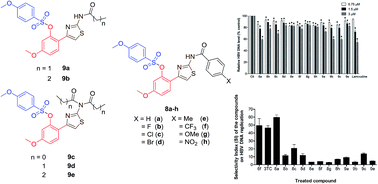Advanced generation of paeonol-phenylsufonyl derivatives as potential anti-HBV agents†
Abstract
Hepatitis B virus (HBV) infection causes serious liver diseases, and the development of effective drugs for chronic hepatitis B treatment remains an important step towards the eradication of HBV worldwide. Recently, our group designed paeonol-phenylsulfonyl derivatives and found that the compound 2-acetyl-5-methoxyphenyl 4-methoxybenzenesulfonate (6f) had the most potent antiviral effect against HBV, with an IC50 value of 0.36 μM and a high selectivity index (SI; TC50/IC50) of 47.75. In this research, we modified compound 6f with a 2-aminothiazole scaffold and generated 13 novel paeonol derivatives by utilizing various benzoyl and acyl chlorides. Among this new generation, compound 2-(2-benzamidothiazol-4-yl)-5-methoxyphenyl 4-methoxybenzenesulfonate (8a) showed the highest SI value of 59.14 which exceeds those of compound 6f and lamivudine (3TC), a commercially available antiviral drug. Hence, we believe that our studies may offer some useful information for the development of antiviral medicines.


 Please wait while we load your content...
Please wait while we load your content...